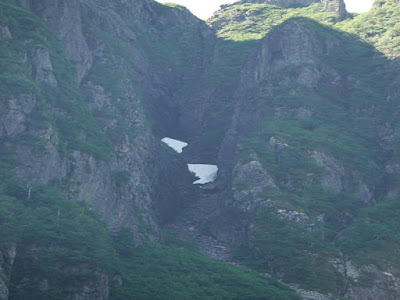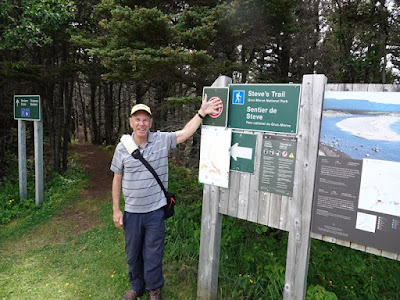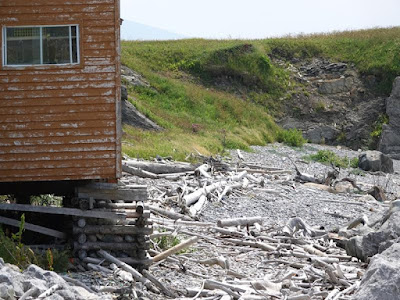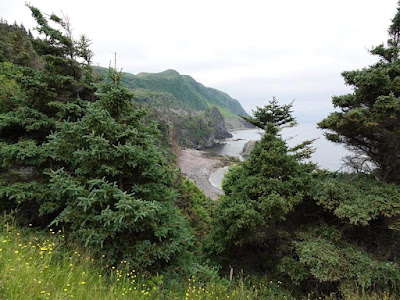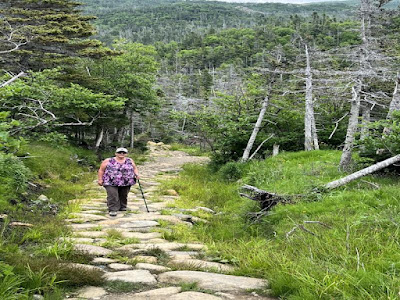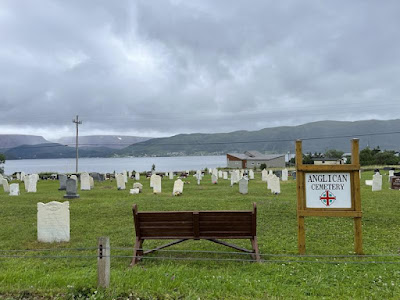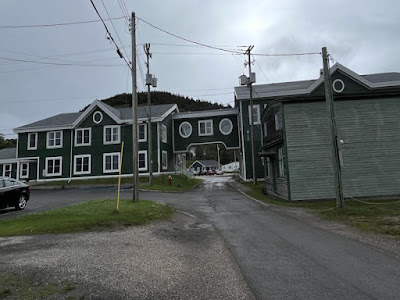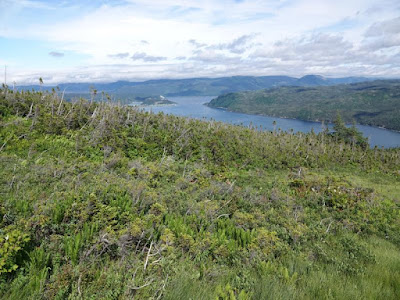Entry 11 – Gros Morne National Park, New Foundland, Canada. – entry 2 July 2022
After our fabulous puffin bird viewing, we relocated down the road a bit from New Foundland’s capital of St. John. We were in another great coastal frontage setting with a couple of islands about a kilometre or so off the coastline. And yes, we could see another colony of puffin birds on the nearby island through our binoculars.
We woke the next morning with our beautiful views missing, covered by a heavy sea fog. We waited and waited hoping for the fog to clear. (As it transpired, we went to bed that evening with no sign of the fog abating.)
When it looked like the fog wasn’t going to subside that day, we decided to take a bit of a drive along the coastal road for a look. In spots we saw nothing but mist and other locations the views were a mistic, eerie setting. It was a different day, compliments of the fog.
We had been in the company of Ernie and Taylor for nearly two and a half months, living in their trailer and travelling in their truck. There had been so many great times and some spectacular scenery. We had travelled to many wonderful locations; some hadn’t been on our radar.
It was time to part company, allowing them time to themselves, whilst continuing with their travels.
We had travelled nearly 20,000 kilometres by air and another 10,000 by road since leaving our home in Australia. We knew we would be travelling out of our normal comfort zone, with our bottoms planted to a seat for long periods of time. It was time for us to participate in our love, to explore those special scenic locations, protected by the title of a “National Park.”
We hired a car, returning to the UNESCO World Heritage listed Site of Gros Morne National Park, documented in our previous edition. We obtained accommodation consisting of a room with a bed and bathroom at Rocky Harbour near the middle of the National Park. We had assessed the weather forecast for the next week, planning our itinerary and making bookings where necessary.
There is a main road travelling through the National Park with many scenic viewing points to stop at. There are also, those extra special locations, accessible via the main road with large parking areas provided to cater for greater volumes of visitors. We planned to stop at as many of these locations as we could manage. Thus, enroute to our accommodation we stopped at several of these wayside locations, tantalising our good feel senses with the marvellous scenery of Gros Morne National Park.
The following morning, we rose early making our way to the Western Brook Pond. This consisted of a 3-kilometre hike to the Pond from a car park.
We spent time admiring the views and setting of the pond.
We boarded a boat for a 2-hour ride along the pond.
The boat ride had been promoted to us by a couple of different people. It didn’t disappoint. It was another fabulous experience, viewing an area inaccessible by foot, with sensational views via a boat. The Western Brook Pond is a 16-kilometre lake with a depth of 165 metres. It is a glacier carved land locked fjord providing a setting for spectacular viewing. Along its length were many water falls, cascading down from its high peaks. It was a wonderful experience; one we suspect will stay in our memory banks for many years.
At the far end of the pond some people with laden back packs were dropped off at a commencement point for a 5-day hike. The saddle in the distant background was the point where a photograph was taken looking down along the Western Brook Pond with its green mountain range either side. This was one of the most spectacular pictures we had picked up on promoting Gros Morne National Park as a location to visit. Annoyingly an opportunity to obtain a similar photograph by ourselves was beyond our body capabilities.
In several places there were still pockets of ice amongst the mountain ranges, caressing the pond, left over from the winter season. It was a cool environment, very different from our Australian environment.
The boat was crowded with people all with a very happy disposition, compliments of the magnificent setting. We even had people photo bombing our pictures.
On our return hike to the carpark, we deviated along another optional circuit track. It felt good to be out there walking amongst beautiful flora.
We were in a windy part of the world with the tree growth dictated by the ferocity of the wind.
Once we were back in our car our thoughts turned to another one of those walking tracks to tick off our wish list, located up the road a bit.
The track came out onto the ocean. They like their fishing in New Foundland and the two fellas in the ocean water were a prime example of the locals.
Nearby was Broom Point, another interesting location. At the National Park Discovery Centre, we had watched a short movie presentation about Gros Morne N.P. One of its references; before the construction of the road into the N.P., fishermen would boat into the waters seeking out their catch. They would bunker down in cottages they had constructed during periods of inclement weather. Some of the cottages at Broom Point were featured in the movie, including the communal loo with its extra special supports.
The following day we walked the Green Gardens trail. It was a hike of around 10 kilometres. It was rated as moderately difficult = bloody difficult back at home. There was a fairly tough descent and an even tougher return hike back up many inclines. The memorable views overrode our protesting bodies.
A slight deviation along another trail at the ocean end of the Green Gardens walk showed how much that Steve guy got around. The two additional pictures below (obtained from “The Room,” museum at St John’s) a few days later revealed the eagle spotted at Green Gardens was about 2 years aged.
The weather forecaster catch phrase over the last few days had been, “the rains are a coming.” We woke one morning to water covered grounds with more rain keeping the puddles full. We spent the best part of the day stopping at any road side stop we could locate. Some were for scenic viewing / photographic opportunities. Others were set up as picnic areas away from the road, all with spectacular, different vistas.
At the National Parks Discovery Centre, we spent a couple of hours reading the provided information about the park’s geology accompanied with plenty of other interesting stuff.
Another location on our wish list was the lookout trail. It was rated as moderately difficult and yes it had some horrible steep sections. Thankfully we thought it didn’t have the same difficulty impact as the green gardens trail. Or there could have been a possibility our fitness levels were getting better? The lookout trail reiterated the splendid scenery of Gros Morne N.P.
We had spent four full days trying to fit in as much scenery as we could. Each day we spent between 8 to 10 hours out and about. At the days end we would return to our accommodation with weary bodies, closing our eyes for the night rather early. The opportunity to be out in amongst some very special nature locations was generously soul pleasing. It had been our biggest “walking,” days since arriving in Canada.
We saw a caption describing Gros Morne N.P. and thought it to be a great description.
Jaw dropping fjords, lush green forests, arctic barrens, and wind-swept shores.
There were many other optional locations we were unable to visit within our time lines.
We were on the other side of the world with limited resources. It would have been a more relaxed experience if we had been travelling with our own tow tug and caravan. We could have easily spent a month or more exploring Gros Morne N.P. It was an impressive location truly worth its world heritage listing. One special picture sighted in the Discovery Centre best showed the vastness of the scenery at Gros Morne N.P.
After five nights at Gros Morne N.P. we headed back to St John’s.
About 500 kilometres down the road, we were about to drive past Terra Nova National Park. We were at Terra Nova N.P. 10 days prior. We were notified at the time by a park ranger about some active beavers in the park but we weren’t in a position to seek out their where abouts. It had been a long day of just driving and we thought a break to be in order and decided to have a look in the area for beavers.
We weren’t expecting much, hoping to spot where the beavers might have been active and not expecting to sight one as we had been informed, they are active at night, rarely sighted.
We found a walking path and set off feeling good, stretching out our legs in a beautiful setting. We did find some beaver looking “dam work” and were feeling content with the sighting of a wall built of sticks and stuff like a dam wall. The water level was about half a metre different either side of the dam wall. In the distance we spotted something gliding along the water surface. Steve attempted to take some photographs with difficulty. Mary got out the binoculars and said, “It’s a Beaver!” Wow. It was an amazing sight. We did come across a taxidermist stuffed beaver a couple of weeks prior, providing a more comprehensive viewing of a beaver. The two additional pictures (obtained from “The Room,” museum at St John’s a day later showed a better model of a beaver.
Our last two nights at New Foundland we spent at the capital, St John’s. With the weather forecast of inclement weather we spent a few hours at “The Rooms,” a fabulous museum depicting the history of New Foundland. The building was positioned for great viewing across the harbour with views of old buildings mixed in with the more modern.
New Foundland was once a thriving cod fishing location, with plenty of information describing the harsh environment and some wonderful examples of its nature. We even took a few special photographs for our grandchildren’s pleasure. And a world map showing our home and our current location shown by two purple dots.
There had been plenty of publicity promoting New Foundland as the Canadian location where you would most likely see moose in the wild. There was some more subdued hinting you might be lucky to see Caribou.
As time progressed during our stay, with our eyes constantly searching into the distant horizon, be it hiking or driving throughout New Foundland our sightings = “0.” We did see a lot of signage.
During times whilst listening to various presentations, our ears picked up on some off the cuff comments like; “the caribou would come down onto the plains from high up in the mountain ranges during winter looking for feed.” It was summer, meaning the caribou were most likely high up in the inaccessible mountains? Another comment; “the moose are non-native and are inflicting a lot of damage to the flora, impacting the land.” And another time; “they are reducing the moose numbers, helping to protect the flora.” At one stage a local said there had been a marked increase with the issuing of licences for moose. Our interpretation = they were being culled? The implication to this story, our only sighting of a moose was in the main street of St John’s.
New Foundland certainly liked their colourful buildings. There was a catch phrase; “come and see jelly bean row,” with its colourful housing. As it transpired there was no road named jelly bean row. It was a publicity stunt. We did find what we thought to be the road, utilised as the publicity photograph. Picture shown has Steve standing on the corner wearing his yellow hat.
We spent the best part of a day on the outskirts of St John’s at Signal Hill. We viewed the “Cabot Tower,” strategically positioned overlooking St John’s harbour, built around the 1897 to 1900th century. It was a historic site with plenty of information about the activities in the area, dating back to the 16th century.
There was a selection of many walking trails in the area around the tower, enticing us to participate.
Canada’s New Foundland would have been one of the most awesome scenic locations we have experienced. We could have easily stayed for a year, soaking in a seemingly endless number of beautiful vistas of New Foundland.
It was time to prepare for a flight south to Toronto.

















































